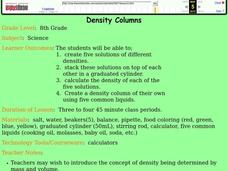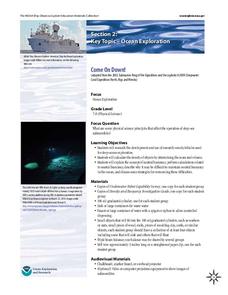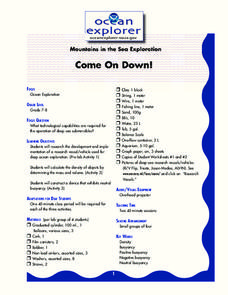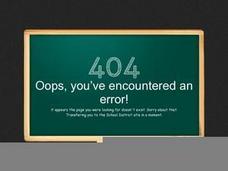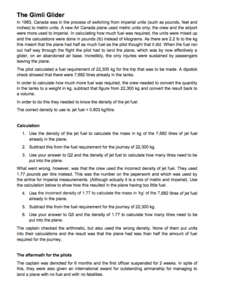Curated OER
Volumw Measurement, English System
Eighth graders biew each volume container and discuss where they have seen them in their home, and how they have seen them used. They explore the different names of volume sizes and their equivalents towards one another. Students...
Curated OER
Float or Sink?
Pupils examine why some objects float while others do not. They place various objects in water to observe their floating capability. Students record the object, its weight, and if the object floated. They construct a graph plotting...
Curated OER
Density Columns
Eighth graders create solutions with 5 different densities. In this chemistry lesson, 8th graders analyze the density of solutions stacked on top of each other. They document their data through graphing. This assignment requires 4 class...
Curated OER
How Dense Are You?
Students examine how density is a value that describes what type of a material an object is made of regardless of its shape or size.
Curated OER
Density
Students, in groups, design a procedure to calculate the mass of gas molecules in the classroom by measuring the volume of the classroom and researching the density of air. They apply changes in air density with altitude and effects on a...
Curated OER
Viscosity and Density
In this viscosity and density pre-lab worksheet, learners define these two terms and determine how to find relative viscosity and the volume of an irregular shaped solid. This worksheet has 13 short answer questions.
Curated OER
Float Your Boat
Students design an experiment to find density using Archimedes' Principle. In this physics lesson plan, students calculate density using mass and volume. They share their findings in class.
Curated OER
Chemical Compounds
In this chemical compounds worksheet, students write the name or chemical formula for the given compounds. Students determine the mass of a cylinder and a given volume of ethanol. This worksheet has 2 fill in the blank questions and 2...
Curated OER
Elements, Compounds, and Mixtures
In this elements, compounds, and mixtures worksheet, learners answer questions about the properties of elements, mixtures, and compounds. Students identify the physical changes that is made to a substance to determine if it is an element.
Virginia Department of Education
States and Forms of Energy
Energy is just energy, right? Explain various forms of energy to your young scientists by using an interactive experiment that contains common objects to demonstrate complex concepts. Pupils conduct experiments for radiant, thermal,...
NOAA
Come on Down!
What do we do when a dive is too dangerous for humans to accomplish? Send in the robots! Middle school scientists get acquainted with several different models of submersible robots in the second lesson of six from NOAA. Lab groups then...
Curated OER
Gas Laws
In this gas laws worksheets, high schoolers figure volumes, densities, molar masses, reactions, and solve equations as they encounter 14 gas laws questions.
Curated OER
Come On Down!
Learners research the implementation of a research vessel used for ocean exploration. In buoyancy instructional activity students will construct a device that shows neutral buoyancy.
Curated OER
Chemistry First Marking Period Review
In this chemistry review worksheet, students review terms and concepts covered. Students practice metric conversions, factor labeling, temperature conversions, heat calculations, atomic structure, and gas laws. This worksheet has 3...
Curated OER
Behavior of Liquids and Gases
In this liquids and gases worksheet, students review 9 vocabulary terms associated with liquids and gases by completing a crossword puzzle.
Curated OER
Unit Conversions
In this unit conversions worksheet, students practice converting measurements to the metric system. This worksheet has 8 problems to solve.
Curated OER
Grade 9 Science Review
In this 9th grade science review worksheet, high schoolers complete 63 true or false questions on topics such as atomic notation, isotopes, covalent bonds, Ohm's law, and electric circuits.
Curated OER
How Does the USS Alabama Float?
Students investigate buoyancy. In this buoyancy lesson, students apply the Archimedes Principle of Buoyancy to the experiment conducted in class to determine how battleships float.
Curated OER
Travelogue of a Planet
Students randomly select a planet, including Earth. They research key features of the planet including mass, volume, density, gravity, temperature, weather, geology, atmosphere, surface features, location from sun, Earth and other...
Curated OER
Changes in the Copper Penny
Third graders explore the difference between a physical change in a substance and a chemical change. students study the volume, density, altering shape and chemistry of a copper penny.
Colorado State University
Can Gravity Push Something Up?
How does a hot air balloon fly? An experimental lesson has scholars build a balloon from a garbage bag and monitor the movement of air. As the temperature of the air in the balloon increases, gravity moves the denser cool air down,...
Teach Engineering
Rock and Boat
Present the class with a question on whether the water level of a pond will rise they take a large rock out of a boat and drop it into the pond. Groups come down on all sides of the question and try to justify their answers. The activity...
Royal Society of Chemistry
Gimli Glider—Anecdotes for Chemistry Teachers
What's the moral of this story? Units save lives! Teach measurement conversion through storytelling in a quick math-based lesson. Young scientists learn how one country's decision to swap from imperial to metric standard units caused an...
Teach Engineering
Archimedes' Principle, Pascal's Law and Bernoulli's Principle
What do Pascal's law, Archimedes' Principle, and Bernoulli's Principle have to do with fluid mechanics? The included PowerPoint presentation provides the basic definitions and equations associated with the three. A set of homework...
Other popular searches
- Density Mass Volume
- Density Mass Volume Equation
- Density Mass Volume Problems
- Density Mass Volume Lab
- Density Mass and Volume
- Density Mass Volume Weight
- Density Is Mass Over Volume
- Density, Volume and Mass




